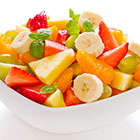At this age, kids can seemingly play forever, their sense of wonder boundless, their energy endless. How best to fuel their growth of both mind and body? Below are the nutrients they need, why they need them, and how best to get them.
AI: Adequate Intake (approximate amount for an average healthy child).
RDA: Recommended Daily Allowance (average intake level sufficient to meet the requirements of 97 percent or more of healthy children; a more precise measure than AI).
ARA (arachidonic acid)
What does it do? ARA is a type of polyunsaturated fatty acid and the key omega-6 fatty acid in the brain. Essential for brain and vision development, ARA is formed in human cells from linoleic acid (another omega-6 fatty acid).
How much does my child need? The AI recommendation from the Institute of Medicine of linoleic acid (precursor of ARA) is 10 g/day.
Where can my child get it? Toddler or growing-up milk, nuts, seeds, and vegetable oils—such as sunflower, safflower, and corn—are sources of omega-6 fatty acids. Meat, poultry, and eggs contain ARA in small amounts.
Calcium
What does it do? It allows for healthy tooth and bone development, aids in blood clotting, and supports nerve and muscle function.
How much does my child need? RDA is 1,000 mg/day.
Where can my child get it? Milk, yogurt, cheese, fortified or enriched grain products, green leafy vegetables (kale, collard greens, mustard greens), sardines, and salmon.
Carbohydrates 
What do they do? Carbohydrates supply energy to fuel your child’s activity and growth; they help protein to be used efficiently in building new tissue. Glucose derived from carbohydrates is the brain’s main source of energy, and a steady supply helps regulate energy, mood, and focus—all essential for learning.
How much does my child need? RDA is 130 g/day.
Where can my child get them? Whole grain products such as breads and cereals, potatoes, corn, legumes, fruits, and vegetables.
Choline
What does it do? Critical to brain development, choline is, in fact, essential for the normal functioning of all cells. It plays a role in memory and learning by supporting brain cell signaling.
How much does my child need? AI is 250 mg/day.
Where can my child get it? Milk, liver, eggs, and peanuts.
DHA (docosahexaenoic acid)
What does it do? DHA is one of two key long-chain omega-3 fatty acids that occur throughout the body (the other is EPA, or eicosapentaenoic acid). They are essential and needed for brain and vision development, and continue to promote healthy brain function and vision throughout life. Omega-3 fatty acids also protect heart health.
How much does my child need? Official recommendations for daily DHA intake haven’t yet been established, but expert group recommendations range from 200 to 300 mg/day for nursing women. At this age, the Food and Nutrition Board of the Institute of Medicine recommends an AI of 0.9 g/day of alpha linolenic acid (as a precursor of DHA and EPA) for toddlers.
Where can my baby get it? Breast milk (but the levels can vary based on the mother’s diet), toddler milk, and fatty coldwater fish—such as salmon, bluefin tuna, black cod, sardines, and herring. Small amounts are also present in meat and eggs.
Fluoride
What does it do? It supports healthy tooth development, strengthening tooth enamel and helping prevent and control tooth decay.
How much does my child need? AI is 1 mg/day.
Where can my child get it? Fluoridated water and supplements (if your main source of drinking water has an insufficient concentration of fluoride).
Folate
What does it do? It helps the development and growth of blood cells and the formation of genetic material in every cell in the brain and throughout the body.
How much does my child need? RDA is 200 mcg/day (as dietary folate equivalent).
Where can my child get it? Liver, green leafy vegetables, legumes, whole grain breads and cereals, fortified or enriched grain products, oranges, cantaloupe, and lean beef.
Iodine
What does it do? Iodine helps regulate cellular growth and the synthesis of thyroid hormones affecting the brain, as well as the muscles, heart, kidneys, and pituitary gland. Deficiency, while very rare in developed countries, can cause neurodevelopmental problems and is the top cause of mental retardation worldwide.
How much does my child need? RDA is 90 mcg/day.
Where can my child get it? Seafood and iodized salt.
Iron
What does it do? Iron is vital to the formation and function of red blood cells, which carry oxygen to the brain and fuel its growth. Deficiency early in life can have a significant impact on mental development and even cause cognitive deficits, motor delays, and behavioral abnormalities.
How much does my child need? RDA is 10 mg/day.
Where can my child get it? Meat, liver, legumes, whole grain breads and cereals, fortified or enriched grain products, and dark green vegetables.
Niacin
What does it do? It helps the body release energy from other nutrients.
How much does my child need? RDA is 8 mg/day.
Where can my child get it? Meat, poultry, fish, whole grain breads and cereals, fortified or enriched grain products, and egg yolks.
Protein
What does it do? Protein helps build, maintain, and repair tissues. It produces hormones, enzymes, and antibodies, helping regulate the body’s processes, and it can provide energy.
How much does my child need? RDA is 19 g/day.
Where can my child get it? Meat, fish, poultry, egg yolks, cheese, yogurt, and legumes.
Riboflavin (vitamin B2)
What does it do? Riboflavin helps the body utilize energy from other nutrients.
How much does my child need? RDA is 0.6 mg/day.
Where can my child get it? Meat, dairy products, egg yolks, legumes, green vegetables, whole grain breads and cereals, and fortified or enriched grain products.
Thiamin (vitamin B1)
What does it do? Thiamin helps the body release energy from carbohydrates and is needed for the nervous system to function. It also plays a central role in brain development and metabolism.
How much does my child need? RDA is 0.6 mg/day.
Where can my child get it? Lean pork; wheat germ; whole grain and enriched breads, cereals, and other grain products; legumes; and potatoes.
Vitamin A 
What does it do? Vitamin A enhances general growth, specifically by building healthy skin, hair, mucous membranes, along with the immune and reproductive systems, and it helps both mental and vision development.
How much does my child need? RDA is 400 mcg/day (as retinol active equivalent).
Where can my child get it? Liver, egg yolks, and dark green and deep yellow fruits and vegetables.
Vitamin B6
What does it do? It helps the body to build tissues and metabolize fat and is essential for the development of the central nervous system. This B vitamin also aids in the synthesis of neurotransmitters, helping to regulate mood and other aspects of brain function.
How much does my child need? RDA is 0.6 mg/day.
Where can my child get it? Liver; meat, whole grain products such as breads and cereals, legumes, and potatoes.
Vitamin B12
What does it do? Vitamin B12 promotes blood cell health, neurological function, and the formation of genetic material in the blood cells.
How much does my child need? RDA is 1.2 mcg/day.
Where can my child get it? Meat, fish, poultry, cheese, egg yolks, and liver.
Vitamin C
What does it do? A component in the formation of collagen—a protein used to build bone, cartilage, muscle, and connective tissue—vitamin C helps maintain healthy capillaries, heal wounds, absorb iron, and fight infections. It’s also thought to play a significant role in brain development.
How much does my child need? RDA is 25 mg/day.
Where can my child get it? Fruits (citrus fruits, papaya, cantaloupe, strawberries) and vegetables (potatoes, cabbage).
Vitamin D
What does it do? Promoting the absorption of calcium and phosphorus, it allows for healthy bone formation and prevents rickets.
How much does my child need? RDA is 15 mcg/day (as cholecalciferol, a form of vitamin D, based on an assumption of minimal sunlight).
Where can my child get it? Egg yolks, liver, fatty fish, and sunlight (synthesized in the body upon exposure of skin to sun).
Vitamin E
What does it do? Vitamin E protects vitamin A and essential fatty acids. It prevents tissue breakdown.
How much does my child need? RDA is 7 mcg/day (as alpha-tocopherol).
Where can my child get it? Green leafy vegetables, vegetable oils, wheat germ, whole grain breads and cereals, fortified or enriched grain products, butter, liver, and egg yolks.
Vitamin K
What does it do? It enables proper blood clotting.
How much does my child need? AI is 55 mcg/day.
Where can my child get it? Vegetable oils, green leafy vegetables, pork, and liver.
Zinc
What does it do? Zinc keeps the immune system strong, as well as helping in wound healing and regulating blood, bone, and tissue formation. Next to iron, it’s the most abundant metal in the brain, and it’s essential to the development and functioning of the central nervous system.
How much does my child need? RDA is 5 mg/day.
Where can my child get it? Meat, liver, egg yolks, oysters and other seafood, whole grain breads and cereals, fortified or enriched grain products, and legumes.
Note: Intake amounts are based on Infant Nutrition and Feeding (2009), published by the United States Department of Agriculture, Food, and Nutrition Service, Special Supplemental Nutrition Program for Women, Infants, and Children. AI for choline comes from Dietary Reference Intakes for Thiamin, Riboflavin, Niacin, Vitamin B6, Folate, Vitamin B12, Pantothenic Acid, Biotin, and Choline, published by the Food and Nutrition Board, Institute of Medicine/The National Academies Press (1998).
References:
What are Dietary Reference Intakes? Available at: http://www.ncbi.nlm.nih.gov/books/NBK45182/
Infant Nutrition and Feeding: USDA. Available at: http://www.nal.usda.gov/wicworks/Topics/FG/CompleteIFG.pdf
“The crucial role of thiamine in the development of syntax and lexical retrieval: A study of infantile thiamine deficiency” by Iris Fattal, Brain (2011).
National Academies Nutrients/ Dietary Reference Intakes: The Essential Guide to Nutrient Requirements (PDF). Available at: http://www.nap.edu/catalog.php?record_id=11537
National Institutes of Health Office of Dietary Supplements: Vitamin D. Available at: http://ods.od.nih.gov/factsheets/VitaminDHealthProfessional
National Institutes of Health Office of Dietary Supplements: Calcium. Available at: http://ods.od.nih.gov/factsheets/Calcium-QuickFacts/
Iodine: NIH Office of Dietary Supplements. Available at: http://ods.od.nih.gov/factsheets/Iodine-HealthProfessional/
B vitamins, NIH Office of Dietary Supplements. Available at:
B12: http://ods.od.nih.gov/factsheets/VitaminB12-HealthProfessional/
B6: http://ods.od.nih.gov/factsheets/VitaminB6-HealthProfessional/
“Omega-3 Fatty Acids and Pregnancy” by Jaclyn M Coletta et al., Rev Obstet Gynecol (2010).
“Why Iron Deficiency Is Important in Infant Development” by John L. Beard, J Nutr (2008).
“Copper and Zinc, Biological Role and Significance of Copper/Zinc Imbalance” by Josko Osredkar and Natasa Sustar, J Clinic Toxicol (2011).



